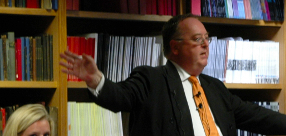
Auction: 9031 - Ancient, English and Foreign Coins and Commemorative Medals
Lot: 70
Frankish Empire, Carolingians, Louis the Pious (814-840), AV Solidus, 4.31g. specific gravity 17.8, 90.0% gold, ?Aachen, 816-819, laureate draped bust right, dn lvdovvicvs imp avg, rev. mvnvs divinvm, cross within laurel wreath (MEC 1, 751- same reverse die; Grierson I, dies -/R4- new obverse die for this issue, struck from rusty dies, obverse die damaged, fine / very fine, an extremely rare and historically important Carolingian coin found in England Estimate £ 8,000-10,000 provenance Found at South Cambridgeshire, September 2009. Recorded with the Fitzwilliam Museum, Cambridge The weight, high gold content, literate legends, detailed rendering of the wreath along with the bust, albeit here struck from a damaged die, confirm this is an ´official´ issue Solidus of Louis the Pious and not an imitation. As such it is an example of one of the most numismatically and historically important, as well as one of the rarest, coins issued by the Carolingian Kings and Emperors. This small gold coinage is thought to have been struck between 816 and 819, possibly but not certainly, at the Imperial capital, Aachen. Grierson linked these Solidii with the Imperial coronation of Louis the Pious by Pope Stephen V at Rheims on 5 October 816. This was regarded in the annals of the period as an event of exceptional importance in both Imperial and Papal circles. The design of this coin is rich in symbolism associated with the imperial coronation of 816 and the Carolingian revival of the Western Roman Empire. The wreath and the legend mvnvs divinvm (the gift of God) is thought to allude to the crown of Constantine the Great said to have been brought from Rome for the coronation, and the legend to its being in God´s gift through the hands of the Pope. The obverse style adopts the image and titles of a Roman emperor. This symbolism enscapulates the spirit more widely expressed in the art of the Carolingian renaissance. Prior to this issue no official gold coinage existed within the Frankish Empire, although there is evidence for the circulation of gold coins in the form of imitative Dinars and a few gold coins in the name of Charlemagne. In addition a precedent existed for gold coinage in the name of a ruler with the issues of Offa and shortly before 816, the gold Mancus of Coenwulf in Anglo-Saxon England. It would seem that Louis decided to introduce an official gold coinage in his name with a weight matching the Byzantine Solidus and Arab Dinar, with this decision linked to the Imperial Coronation in 816. This coinage seems to have had some success with extensive imitation of the mvnus divinvm type around the southern North Sea trade area over the next 60-70 years as well with the Mancus of Archbishop Wigmund of York c.840. It is possible that official issues of the Solidus occurred intermittently later in Louis´s reign, as may be suggested by the damaged and possibly rusty dies used on this coin, but overall output must have been small. Examples of the ´official´ issue coins are all extremely rare. Grierson (1951, revised and reprinted 1979) listed thirteen examples. At that time five were of unknown whereabouts. The other eight are listed below. Whilst new examples of imitative Solidii turn up from time to time (see Spink auction 199, June 25th 2009, lot 476, realised £8000), fresh examples of the official issue Solidii are almost unknown. 1. Brussels, Bibliothèque royale, 3.43g, dies O1/R1, clipped, found Zeeland, first noted by R Serrure, 1885-1886 2. Cambridge, Fitzwilliam Museum, mounted in a pearl border, 5.56g, dies O2/R2, ex Grierson collection and Motte sale lot 109, MEC 750 3. Paris, Bibliothèque National, bt. 1896, 4.35g, dies O3/R3 4. Munich, Staatliche Munzsammlung, 4.39g, dies O3/R3 5. Baltimore, John Hopkins University (Garrett collection), ex Jenks sale 1921, lot 1845 6. Paris, Bibliothèque National, 4.32g, dies O4/R4 7. London, British Museum, Banks gift, 1877, 4.36g, dies O4/R4 8. Cambridge, Fitzwilliam Museum, 4.32g, ex Grierson, ex Grantley lot 189, ex Carlyon Britton, dies O4/R4- same reverse dies as this new coin, MEC 751 To these can be added 9. Cambridge, Fitzwilliam Museum, cut quarter, 1.16g, found at Torksey, Lincs, in 1997 (previously incorrectly listed as from Louth), EMC 1997.0101- and Spink auction 126, 14 July 1998, lot 270. 10. Berlin, Munzkabinett, Staatliche Museen, Kluge, 2007, Table 11, no. 241, no weight stated, similar but different dies (possibly number 5 ´whereabouts unknown´ on Grierson´s list).
Sold for
£15,000




